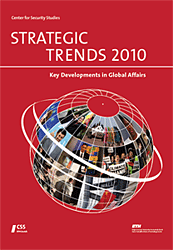
The Center for Security Studies (CSS) has released the inaugural publication, Strategic Trends 2010. Offering a concise annual analysis of major developments in world affairs, Strategic Trends’ primary focus is international security.
Along with the publication, the CSS has also launched the website Strategic Trends Analysis, where you will find both Strategic Trends and the complementary policy brief series CSS Analysis in Security Policy. The website also features graphics, audio and video podcasts, and a discussion forum on current security issues. You can also sign up for the Strategic Trends newsletter to learn about new publications.
Last year was noted as a year of crisis by our in-house policy experts, but 2010 remains a highly uncertain period for recovery. This is not only relates to economics, but broader security threats.
Geoeconomic shifts eastward, energy security, nuclear proliferation, a crisis of political conflict management, and US approaches toward South Asia and the Middle East will be most critical challenges hitting international headlines in 2010.
Sitting at the heart of these policy dilemmas remains a lack of effective global governance. We were presented with formidable challenges in 2009. This year, novel ideas have either been lacking or proven politically impossible to implement. With power gradually shifting from the West to the East, finding effective solutions to global governance questions will become ever more complex.
The strategic outlook: Five key trends
- Geoeconomic power has made a significant shift the East, and most notably toward China, not least because the financial and economic crisis has been a defining trend of international affairs over the past two years. The West now has huge liabilities from stepping in to save the financial system, and took a further fiscal hit when launching stimulus measures to rekindle economic growth. China adopted similar measures, but has emerged far stronger from the crisis so far. The East’s newfound geo-economic clout will take a long time to translate into geopolitical gains, but international institutions have to adapt sooner rather than later to these power shifts.
- US foreign policy will be dominated by ongoing challenges in South Asia and the Middle East. US President Barack Obama’s new approaches to Afghanistan, the Iran nuclear crisis, and the Israeli-Palestinian conflict have failed to translate into policy success so far. Tough choices lie ahead, as he needs to reconcile policies on Afghanistan and Pakistan, reassess engagement with Iran, and decide about more robust mediation in the Middle East conflict. Preparing to exit from Iraq is an additional challenge. The scope for progress remains slim, with domestic issues likely to increasingly dominate Obama’s agenda in 2010.
- Nuclear disarmament and nonproliferation will face critical tests in 2010. Taking the lead on this issue, Washington has made nuclear disarmament the cornerstone of its nonproliferation policy. It has resumed talks with Russia on a post-START treaty, reopened the domestic debate on ratifying the CTBT, and pushed for talks on reducing fissile material stockpiles. Obama went as far as calling for the abolition of nuclear weapons. But the link between disarmament and nonproliferation is weaker than many think; prospects for strengthening the Non-Proliferation Treaty thus remain unlikely. Iran and North Korea will remain the most obvious and important test cases in this regard in 2010.
- Energy security has been high on the agenda in 2009-2010. When oil prices turned from highs of $147/b into lows of $33/b, the demise of producer regimes was expected to follow. But amid the crisis, producers proved to be politically resilient, with production cuts playing an important role. Their political survival is now being turned into sharpened resource nationalism into 2010, a trend that is likely to increase in coming years as supply-demand fundamentals tighten. Prices have already lifted to over $ 80/b; consumers are feeling the brunt. Unless lessons are learned to forge greater producer-consumer cooperation, all states will lose out. If nothing else, the failure of climate negotiations at Copenhagen shows that international consensus on how to approach hydrocarbons, or indeed the emissions they produce, remains a long way off.
- Crisis management to address political violence has been in record demand in 2009-2010. Yet it continues to suffer from three major failings. First, there is insufficient political will to formulate a strategic vision of how to address violent conflicts in an increasingly multipolar world. Second, there is a lack of institutional coordination among the principal providers of crisis management. Third, due to capability shortages, many operations struggle to deliver in today’s complex conflict environments. These flaws must be fixed as crisis management remains an indispensible tool to secure peace and stability. We can expect conflicts in Somalia, Yemen, Guinea and Sudan to deepen in 2010, while Afghanistan could get worse before it slowly gets better.
Until we see greater consensus on issues of global governance across the board, and the political desire to address deep seated flaws, we can expect security dynamics to worsen in the coming years. The key trends identified by the Center of geoeconomic shifts east, US foreign policy approaches, proliferation, energy security, and crisis management of political conflict in 2009-2010 will sit at the heart of these governance concerns. Getting policies right in these areas will inevitably relate to other challenges of regional security, maritime security, terrorism, state resilience and resource management.

